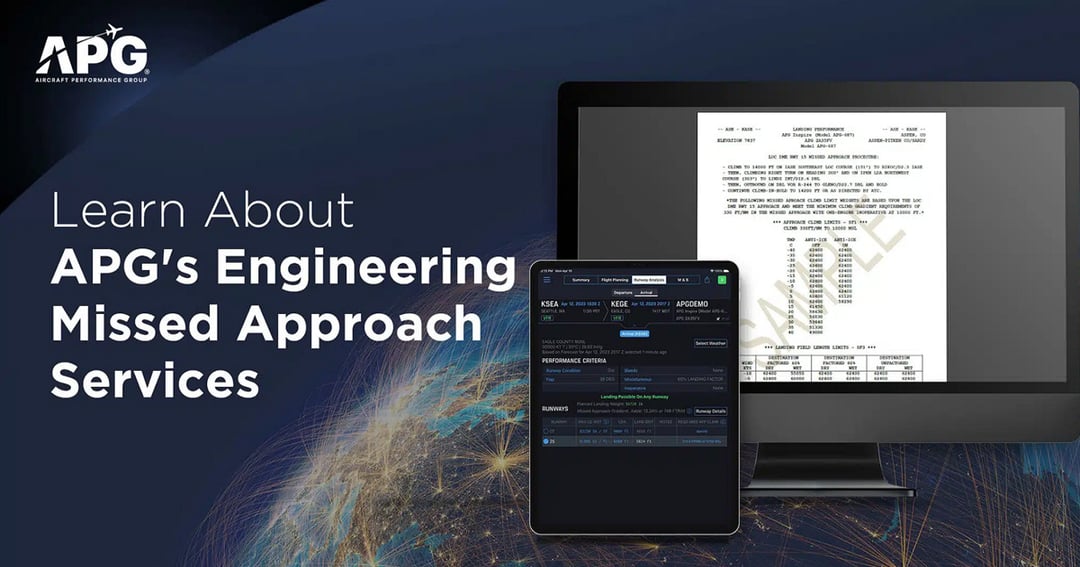
One of the critical questions a pilot must ask when determining if a runway is suitable for landing is, “What happens if I need to abort the landing and go around?” The pilot must understand if they can climb and clear all obstacles and terrain and avoid interference from any other air traffic in the area.
There are various reasons why a pilot may need to execute a missed approach. These reasons could include a non-stabilized approach, a runway incursion by another vehicle or wildlife, a command from ATC, or any other general reason that may make the pilot feel that continuing with the landing may not be safe.
This scenario of executing a missed approach is applicable in two configurations.
Missed Approach
For this configuration, the aircraft is required to fly the missed approach climb speed, commonly referred to as VAPP or VAC, the flaps are in the missed approach position, the thrust is at go-around power and the landing gear is retracted. For multi-engine aircraft, by regulation, this climb is modeled with one engine inoperative.
It is important to identify that VAPP and the Missed Approach flap setting may differ from the approach speed and flap setting used during the approach.
Operationally, this configuration is considered to be executed from the Missed Approach point.
Balked Landing
This configuration assumes all engines operating, landing flaps, thrust at go-around power, landing gear extended and the aircraft is flying the VREF speed. This configuration is considered to be executed any time after the Missed Approach point.
Because the Balked Landing configuration assumes all engines operating for engine aircraft, this climb gradient is commonly several times larger than the Missed Approach climb gradient, even after accounting for the increased drag due to the higher flap setting and the landing gear extended.
To ensure the Missed Approach and Balked Landing climb gradients are at least minimally considered, the aircraft certification requirements include minimum climb gradient requirements for all conditions. The flight manual presents the minimum requirements and usually has a title similar to “Maximum Landing Weight Permitted by Climb Requirements.”
For example, Part 25 certification requirements list the following climb requirements for Missed Approach and Balked Landing:
§ 25.119 Landing climb: All-engines-operating.
In the landing configuration, the steady gradient of climb may not be less than 3.2 percent, with the engines at the power or thrust that is available 8 seconds after initiation of movement of the power or thrust controls from the minimum flight idle to the go-around power or thrust setting—
(a) In non-icing conditions, with a climb speed of VREF determined in accordance with § 25.125(b)(2)(i); and
(b) In icing conditions with the most critical of the landing ice accretion(s) defined in Appendices C and O of this part, as applicable, in accordance with § 25.21(g), and with a climb speed of VREF determined in accordance with § 25.125(b)(2)(ii).
§ 25.121 Climb: One-engine-inoperative.
(d) Approach. In a configuration corresponding to the normal all-engines-operating procedure in which VSR for this configuration does not exceed 110 percent of the VSR for the related all-engines-operating landing configuration:
(1) The steady gradient of climb may not be less than 2.1 percent for two-engine airplanes, 2.4 percent for three-engine airplanes, and 2.7 percent for four-engine airplanes, with—
(i) The critical engine inoperative, the remaining engines at the go-around power or thrust setting;
(ii) The maximum landing weight;
(iii) A climb speed established in connection with normal landing procedures, but not exceeding 1.4 VSR; and
(iv) Landing gear retracted.
While these weight limitations presented in the flight manual cover the regulatory requirements, the environment around an airport may require a larger climb gradient than the minimum regulatory required climb gradient.
One example includes this note for the Eagle County Regional Airport (KEGE) LDA RWY 25:

iPreFlight Genesis® Performance, iPreFlight Genesis Navigator and iPreFlight Genesis PRO support entry of specific missed approach gradients, either as a percentage climb gradient or in feet per nautical mile, to the specified altitude.

Once entered, calculation will limit the maximum allowed landing weight, if necessary, to meet the climb requirement. This analysis is completed utilizing the Missed Approach configuration.
While this solution meets the requirements for published missed approach climb gradients, many operators wish to consider alternate profiles. For that purpose, our Engineering Consulting Service is highly qualified at modeling alternate scenarios. For many operators, we have modeled:
- Climbing in the Balked Landing configuration
- Obstacle and terrain analysis to determine minimum climb requirements and minimum safe altitudes
- Analyses for private airfields without published procedures
- Custom designed missed approach procedures
Our Engineering team creates custom reports to the operators’ specifications for these scenarios.

Contact us today if your business needs custom reports like the sample above.
APG offers various consulting services to help airlines, operators, and customers achieve their goals. Whether you need to optimize aircraft performance, improve flight operations procedures, or ensure regulatory compliance, APG has the expertise to help. Contact us today to learn more about our other services and how we can help your organization succeed.


